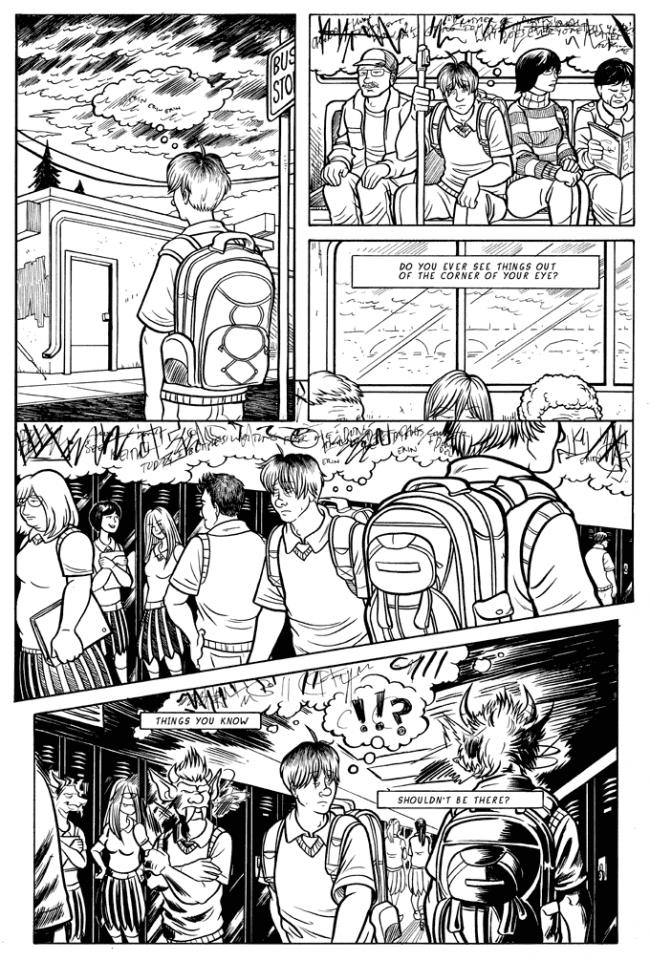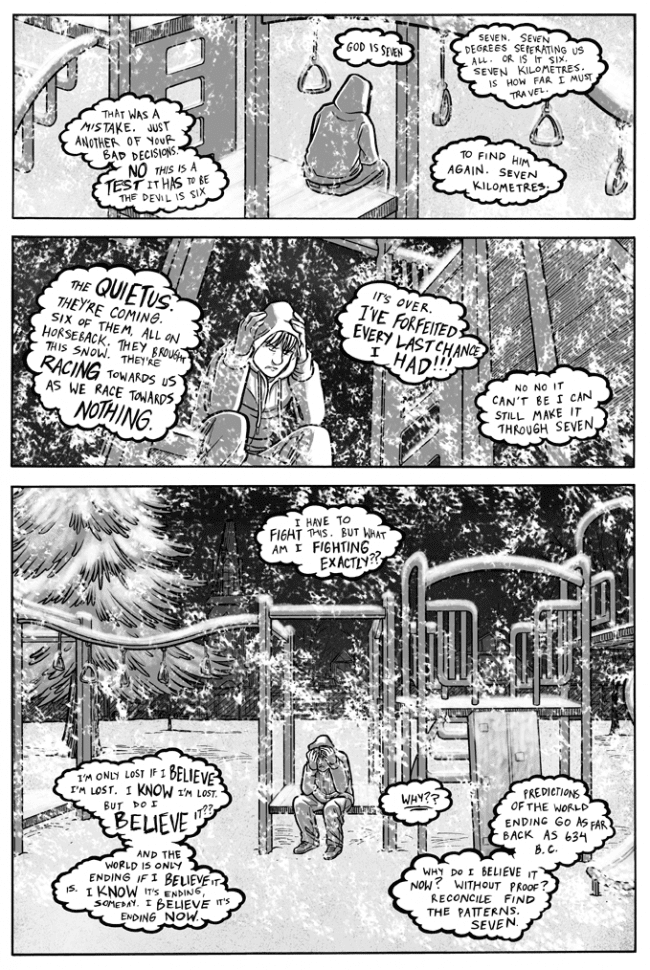The depressed, bullied, and delusional teen boy at the center of Elaine M. Will's debut graphic novel initially surfaced within her often unpredictable panels in 2009. The Canadian comics writer and artist began putting rough concepts together for a webcomic before she was awarded one of the last self-publishing grants from the Xeric Foundation, which has since shifted from bestowing grants upon the comics community to a strict diet of charity donations. In her now-print story, Will follows seventeen year-old budding artist Jeremy Knowles through the halls of his high school, where he battles a swiftly deepening identity crisis, hallucinations, and the detrimental sense of ignorance of his mental illness that awaits him at every turn. Owing to the struggles that Will has experienced since she was a kid, the wealth of hurt in Look Straight Ahead gathers like a storm in the frames dominated by Knowles's shouting, frustrated father and in his dealings with typical schoolyard bullies. "It's bad enough that everyone I go to school with hates me and wants to kill me," Jeremy explains when finally ushered to a medical facility. His serial defeats, under the great weight of a disorder, are palpable and heartbreaking while Will's pens dazzle.
Psychedelic abstractions are as commonplace as the straight framing of Look Straight Ahead's narrative. Within Will's first few pages, Jeremy Knowles envisions a total loss of his physical form in front of lockers at school -- his crush Erin (who dates his friend Keith) brushes past him in the corridor and he's unable to speak. He's reduced to a gloopy puddle on Will's page, the structure of which is affected just as much by the action as her characters, with the lines that box-in the panels loosening and caving amid Knowles's meltdown. Will's rendering of Jeremy's experiences early-on proves jarring, but it's hardly the most fantastic that things get. The creator strays frequently from the reader's here-and-now, producing an onslaught of swirling, sprawling depictions of the happenings within Knowles's crowded headspace (including numerous encounters with dragon-headed beasts). In rare but radiant instances, these take the shape of abrupt rushes of rich color that stand out on her otherwise stark white pages. Will's teen is prevented from making simple decisions, interacting with others, or progressing capably through his day without suffering the paralysis of depression. The building of these moments is magnificent, and it's easy to get lost in the dizzying flow of how Jeremy's hallucinations are strewn about the book. That the style and often the framework of Look Straight Ahead's illusions differ enormously from page to page is indeed captivating, but these episodes -- and the related after-effects that so frequently constrict Jeremy -- are far more purposeful than ornamental.
A 2011 case study published in the Indian Journal of Psychological Medicine focused on a 22 year-old woman who had been undergoing treatment for bipolar disorder and reported seeing images of God. She complained of insomnia, had grown irritable with her parents, and believed she was meant to take on a more important role in her home state. Jeremy's days in Look Straight Ahead are fraught with similar strains: he battles with most others around him, imagines Erin with angel's wings, and holds regular conversations with apparitions, certain that he is to act on orders from The Divine. "I hallucinated. The world was suddenly up for grabs; reality, an option," wrote Linda Logan of her bipolar disorder in an April 2013 New York Times essay. "Rectangular rainbows streamed through the day-room windows," she recalled. "Nonexistent organ music pealed through the neighborhood on a Sunday morning." Hallucinations can sometimes materialize as a feature of severe bipolar disorder, to which Elaine Will had attributed Jeremy's problems in a 2009 blog post.
When the author began uploading pages from what would eventually become Look Straight Ahead back in 2010, the results of a survey of more than 10,000 American teens ages 13 to 18 were published in the Journal of the American Academy of Child and Adolescent Psychiatry. Nearly half of the respondents reported having "met criteria for at least one (mental) disorder over a lifetime," while more than ten percent of the teenagers indicated that they'd experienced severe impairment due to a mood disorder such as depression. Bipolar disorder can feature an erratic combination of highs and lows, where children and teens encounter both manic and depressive symptoms, the latter of which includes irritability, persistent sadness, and insomnia’s subset of symptoms, such as awakenings from sleep or inadequate sleep quality.
There isn't any semblance of a full night's rest in Look Straight Ahead. Jeremy lumbers zombie-like through aggravating daily dialogues, having barely closed his eyes for an hour during the previous twelve. A detailed outdoor sequence brightened with quick, lively perspective shifts, such as the view from a car's side mirror, lands a collapsed Knowles on a snowy sidewalk, hallucinating and humiliated, neighbors circling. Earlier, Will tiles one splash page with the cruel face of her protagonist's alarm clock, the display's irregular intervals bookended by two distinct illustrations of Jeremy's exhausted mug. The styles differ so significantly -- a common wonder throughout the book -- that it's as if this page is the work of two artists. There's both traditional, bare newspaper-strip linework and more nuance at the top, with Will establishing the agony of half-slumber via an overhead view of Jeremy. Textured gray watercolors and menacing smoky wafts curl into chisel-tip points above his head. Dynamic pages like this one are marked with the influence of creators like Nate Powell, who covered similar ground for Swallow Me Whole. Will sets herself apart in regularly varying execution, however, and here, in positioning two divergent conceptualizations of one sequence on a single page. But it isn't just bold drafting. As often as we marvel at the manifestation of Jeremy's delusions in Look Straight Ahead, at the spacescapes, littered with puzzle pieces that float freely within the book's gutters, there is a sympathetic unearthing of the hardships that affect about one in four American adults here. Will's pages stir and stun in their blur of off-kilter aesthetics, but they're ultimately drawing attention to her deft and worthwhile examination of a truly difficult subject matter.







